Use of Spent Coffee Ground as an Alternative Fuel and Possible Soil Amendment
Abstract
:1. Introduction
2. Materials and Methods
2.1. Proximate and Ultimate Analysis
2.2. Stochiometric Analysis
These Calculations Determine
2.3. Phytotoxicity Test
2.3.1. Preparation of the Extract
2.3.2. Seed Germination Test
2.3.3. Statistical Analysis
3. Results and Discussion
3.1. Proximate and Ultimate Analysis
3.2. Stochiometric Analysis
3.3. Phytotoxicity Test
4. Conclusions
Author Contributions
Funding
Institutional Review Board Statement
Informed Consent Statement
Data Availability Statement
Conflicts of Interest
References
- International Coffee Organization-What’s New. Available online: https://www.ico.org/ (accessed on 26 August 2022).
- International Coffee Organization-Trade Statistics Tables. Available online: https://www.ico.org/trade_statistics.asp?section=Statistics (accessed on 26 August 2022).
- Rajesh Banu, J.; Yukesh Kannah, R.; Dinesh Kumar, M.; Preethi; Kavitha, S.; Gunasekaran, M.; Zhen, G.; Awasthi, M.K.; Kumar, G. Spent Coffee Grounds Based Circular Bioeconomy: Technoeconomic and Commercialization Aspects. Renew. Sustain. Energy Rev. 2021, 152, 111721. [Google Scholar] [CrossRef]
- Semida, W.M.; Beheiry, H.R.; Sétamou, M.; Simpson, C.R.; Abd El-Mageed, T.A.; Rady, M.M.; Nelson, S.D. Biochar implications for sustainable agriculture and environment: A review. S. Afr. J. Bot. 2019, 127, 333–347. [Google Scholar] [CrossRef]
- Mussatto, S.I.; Machado, E.M.S.; Martins, S.; Teixeira, J.A. Production, Composition, and Application of Coffee and Its Industrial Residues. Food Bioproc. Tech. 2011, 4, 661–672. [Google Scholar] [CrossRef]
- Campos-Vega, R.; Loarca-Piña, G.; Vergara-Castañeda, H.A.; Oomah, B.D. Spent Coffee Grounds: A Review on Current Research and Future Prospects. Trends Food Sci. Technol. 2015, 45, 24–36. [Google Scholar] [CrossRef]
- Tokimoto, T.; Kawasaki, N.; Nakamura, T.; Akutagawa, J.; Tanada, S. Removal of Lead Ions in Drinking Water by Coffee Grounds as Vegetable Biomass. J. Colloid. Interface Sci. 2005, 281, 56–61. [Google Scholar] [CrossRef]
- Kovalcik, A.; Obruca, S.; Marova, I. Valorization of Spent Coffee Grounds: A Review. Food Bioprod. Process. 2018, 110, 104–119. [Google Scholar] [CrossRef]
- Malaták, J.; Velebil, J.; Bradna, J.; Gendek, A.; Tamelová, B. Evaluation of Co and NoxEmissions in Real-Life Operating Conditions of Herbaceous Biomass Briquettes Combustion. Acta Technol. Agric. 2020, 23, 53–59. [Google Scholar]
- Richelle, M.; Tavazzi, I.; Offord, E. Comparison of the Antioxidant Activity of Commonly Consumed Polyphenolic Beverages (Coffee, Cocoa, and Tea) Prepared per Cup Serving. J. Agric. Food Chem. 2001, 49, 3438–3442. [Google Scholar] [CrossRef]
- Ballesteros, L.F.; Teixeira, J.A.; Mussatto, S.I. Chemical, Functional, and Structural Properties of Spent Coffee Grounds and Coffee Silverskin. Food Bioproc. Tech. 2014, 7, 3493–3503. [Google Scholar] [CrossRef]
- Malara, A.; Paone, E.; Frontera, P.; Bonaccorsi, L.; Panzera, G.; Mauriello, F. Sustainable Exploitation of Coffee Silverskin in Water Remediation. Sustainability 2018, 10, 3547. [Google Scholar] [CrossRef]
- Cruz, R.; Cardoso, M.M.; Fernandes, L.; Oliveira, M.; Mendes, E.; Baptista, P.; Morais, S.; Casal, S. Espresso Coffee Residues: A Valuable Source of Unextracted Compounds. J. Agric. Food Chem. 2012, 60, 7777–7784. [Google Scholar] [CrossRef] [PubMed]
- Belitz, H.D.; Grosch, W.; Schieberle, P. Food Chemistry. Food Chem. 2009, 65–69. [Google Scholar] [CrossRef]
- Pujol, D.; Liu, C.; Gominho, J.; Olivella, M.À.; Fiol, N.; Villaescusa, I.; Pereira, H. The Chemical Composition of Exhausted Coffee Waste. Ind Crops Prod. 2013, 50, 423–429. [Google Scholar] [CrossRef]
- Fraňková, A.; Drábek, O.; Havlík, J.; Száková, J.; Vaněk, A. The Effect of Beverage Preparation Method on Aluminium Content in Coffee Infusions. J. Inorg. Biochem. 2009, 103, 1480–1485. [Google Scholar] [CrossRef] [PubMed]
- Kondamudi, N.; Mohapatra, S.K.; Misra, M. Spent Coffee Grounds as a Versatile Source of Green Energy. J. Inorg. Biochem. 2008, 56, 11757–11760. [Google Scholar] [CrossRef]
- Caetano, N.S.; Silvaa, V.F.M.; Mata, T.M. Valorization of Coffee Grounds for Biodiesel Production. Chem. Eng. Trans. 2012, 26, 267–272. [Google Scholar] [CrossRef]
- McNutt, J.; He, Q. (Sophia) Spent Coffee Grounds: A Review on Current Utilization. J. Ind. Eng. Chem. 2019, 71, 78–88. [Google Scholar] [CrossRef]
- Mata, T.M.; Martins, A.A.; Caetano, N.S. Bio-Refinery Approach for Spent Coffee Grounds Valorization. Bioresour. Technol. 2018, 247, 1077–1084. [Google Scholar] [CrossRef]
- Bejenari, V.; Marcu, A.; Ipate, A.M.; Rusu, D.; Tudorachi, N.; Anghel, I.; Şofran, I.E.; Lisa, G. Physicochemical Characterization and Energy Recovery of Spent Coffee Grounds. J. Mater. Res. Technol. 2021, 15, 4437–4451. [Google Scholar] [CrossRef]
- Tehrani, N.F.; Aznar, J.S.; Kiros, Y. Coffee Extract Residue for Production of Ethanol and Activated Carbons. J. Clean. Prod. 2015, 91, 64–70. [Google Scholar] [CrossRef]
- Colantoni, A.; Paris, E.; Bianchini, L.; Ferri, S.; Marcantonio, V.; Carnevale, M.; Palma, A.; Civitarese, V.; Gallucci, F. Spent Coffee Ground Characterization, Pelletization Test and Emissions Assessment in the Combustion Process. Sci. Rep. 2021, 11, 1–14. [Google Scholar] [CrossRef]
- Tamelová, B.; Malaťák, J.; Velebil, J.; Gendek, A.; Aniszewska, M. Energy Utilization of Torrefied Residue from Wine Production. Materials 2021, 14, 1610. [Google Scholar] [CrossRef] [PubMed]
- Kante, K.; Nieto-Delgado, C.; Rangel-Mendez, J.R.; Bandosz, T.J. Spent Coffee-Based Activated Carbon: Specific Surface Features and Their Importance for H 2S Separation Process. J. Hazard. Mater. 2012, 201–202, 141–147. [Google Scholar] [CrossRef] [PubMed]
- Silva, M.A.; Nebra, S.A.; Machado Silva, M.J.; Sanchez, C.G. The Use of Biomass Residues in the Brazilian Soluble Coffee Industry. Biomass Bioenergy 1998, 14, 457–467. [Google Scholar] [CrossRef]
- Li, X.; Strezov, V.; Kan, T. Energy Recovery Potential Analysis of Spent Coffee Grounds Pyrolysis Products. J. Anal. Appl. Pyrolysis 2014, 110, 79–87. [Google Scholar] [CrossRef]
- Sen, K.Y.; Baidurah, S. Renewable Biomass Feedstocks for Production of Sustainable Biodegradable Polymer. Curr. Opin. Green. Sustain. Chem. 2021, 27, 100412. [Google Scholar] [CrossRef]
- Akbari, M.; Oyedun, A.O.; Kumar, A. Techno-Economic Assessment of Wet and Dry Torrefaction of Biomass Feedstock. Energy 2020, 207. [Google Scholar] [CrossRef]
- Tamelová, B.; Malaťák, J.; Velebil, J. Energy Valorisation of Citrus Peel Waste by Torrefaction Treatment. Agron. Res. 2018, 16, 276–285. [Google Scholar] [CrossRef]
- Jutakridsada, P.; Prajaksud, C.; Kuboonya-Aruk, L.; Theerakulpisut, S.; Kamwilaisak, K. Adsorption Characteristics of Activated Carbon Prepared from Spent Ground Coffee. Clean. Technol. Env. Policy 2016, 18, 639–645. [Google Scholar] [CrossRef]
- Lee, N.; Kim, S.; Lee, J. Valorization of Waste Tea Bags via CO2-Assisted Pyrolysis. J. CO2 Util. 2021, 44, 101414. [Google Scholar] [CrossRef]
- Rajesh Banu, J.; Kavitha, S.; Yukesh Kannah, R.; Dinesh Kumar, M.; Preethi; Atabani, A.E.; Kumar, G. Biorefinery of Spent Coffee Grounds Waste: Viable Pathway towards Circular Bioeconomy. Bioresour. Technol. 2020, 302, 122821. [Google Scholar] [CrossRef] [PubMed]
- Yang, L.; He, Q.; Havard, P.; Corscadden, K.; Xu, C. (Charles); Wang, X. Co-Liquefaction of Spent Coffee Grounds and Lignocellulosic Feedstocks. Bioresour. Technol. 2017, 237, 108–121. [Google Scholar] [CrossRef]
- Lessa, E.F.; Nunes, M.L.; Fajardo, A.R. Chitosan/Waste Coffee-Grounds Composite: An Efficient and Eco-Friendly Adsorbent for Removal of Pharmaceutical Contaminants from Water. Carbohydr. Polym. 2018, 189, 257–266. [Google Scholar] [CrossRef] [PubMed]
- Levy, D.; Reinecke, J.; Manning, S. The Political Dynamics of Sustainable Coffee: Contested Value Regimes and the Transformation of Sustainability. J. Manag. Stud. 2016, 53, 364–401. [Google Scholar] [CrossRef]
- Fermoso, J.; Mašek, O. Thermochemical Decomposition of Coffee Ground Residues by TG-MS: A Kinetic Study. J. Anal. Appl. Pyrolysis 2018, 130, 249–255. [Google Scholar] [CrossRef]
- Pfluger, R.A. Soluble Coffee Processing. Solid Wastes Orig. Collect. Process. Disposal. C.l. Mantell 1975, 39, 245–247. [Google Scholar]
- Mukherjee, A.; Borugadda, V.B.; Dynes, J.J.; Niu, C.; Dalai, A.K. Carbon Dioxide Capture from Flue Gas in Biochar Produced from Spent Coffee Grounds: Effect of Surface Chemistry and Porous Structure. J. Env. Chem. Eng. 2021, 9, 106049. [Google Scholar] [CrossRef]
- Adeleke, A.A.; Odusote, J.K.; Ikubanni, P.P.; Lasode, O.A.; Malathi, M.; Paswan, D. Essential Basics on Biomass Torrefaction, Densification and Utilization. Int. J. Energy Res. 2021, 45, 1375–1395. [Google Scholar] [CrossRef]
- Phanphanich, M.; Mani, S. Impact of Torrefaction on the Grindability and Fuel Characteristics of Forest Biomass. Bioresour. Technol. 2011, 102, 1246–1253. [Google Scholar] [CrossRef]
- Kelkar, S.; Saffron, C.M.; Chai, L.; Bovee, J.; Stuecken, T.R.; Garedew, M.; Li, Z.; Kriegel, R.M. Pyrolysis of Spent Coffee Grounds Using a Screw-Conveyor Reactor. Fuel Process. Technol. 2015, 137, 170–178. [Google Scholar] [CrossRef]
- Bridgeman, T.G.; Jones, J.M.; Williams, A.; Waldron, D.J. An Investigation of the Grindability of Two Torrefied Energy Crops. Fuel 2010, 89, 3911–3918. [Google Scholar] [CrossRef]
- Afolabi, O.O.D.; Sohail, M.; Cheng, Y.L. Optimisation and Characterisation of Hydrochar Production from Spent Coffee Grounds by Hydrothermal Carbonisation. Renew. Energy 2020, 147, 1380–1391. [Google Scholar] [CrossRef]
- Mayson, S.; Williams, I.D. Applying a Circular Economy Approach to Valorize Spent Coffee Grounds. Resour. Conserv. Recycl. 2021, 172. [Google Scholar] [CrossRef]
- Bondarovich, H.A.; Friedel, P.; Krampl, V.; Renner, J.A.; Shephard, F.W.; Gianturco, M.A. Volatile Constituents of Coffee. Pyrazines and Other Compounds. J. Agric. Food Chem. 1967, 15, 1093–1099. [Google Scholar] [CrossRef]
- Xie, T.; Reddy, K.R.; Wang, C.; Yargicoglu, E.; Spokas, K. Characteristics and Applications of Biochar for Environmental Remediation: A Review. Crit. Rev. Env. Sci. Technol. 2015, 45, 939–969. [Google Scholar] [CrossRef]
- Chen, Y.C.; Jhou, S.Y. Integrating Spent Coffee Grounds and Silver Skin as Biofuels Using Torrefaction. Renew. Energy 2020, 148, 275–283. [Google Scholar] [CrossRef]
- Plaza, M.G.; González, A.S.; Pevida, C.; Pis, J.J.; Rubiera, F. Valorisation of Spent Coffee Grounds as CO2 Adsorbents for Postcombustion Capture Applications. Appl. Energy 2012, 99, 272–279. [Google Scholar] [CrossRef]
- Leoni, E.; Mancini, M.; Aminti, G.; Picchi, G. Wood Fuel Procurement to Bioenergy Facilities: Analysis of Moisture Content Variability and Optimal Sampling Strategy. Processes 2021, 9, 359. [Google Scholar] [CrossRef]
- Hnilička, F.; Hniličková, H.; Kudrna, J.; Kraus, K.; Kukla, J.; Kuklová, M. Combustion Calorimetry and Its Application in the Assessment of Ecosystems. J. Therm. Anal. 2020, 142, 771–781. [Google Scholar] [CrossRef]
- Malaťák, J.; Gendek, A.; Aniszewska, M.; Velebil, J. Emissions from Combustion of Renewable Solid Biofuels from Coniferous Tree Cones. Fuel 2020, 276, 118001. [Google Scholar]
- Rawat, J.; Saxena, J.; Sanwal, P. Biochar: A Sustainable Approach for Improving Plant Growth and Soil Properties. In Biochar—An Imperative Amendment for Soil and the Environment; IntechOpen: London, UK, 2019. [Google Scholar] [CrossRef]
- Lehmann, J.; Joseph, S. Biochar for Environmental Management: An Introduction (Pp. 33–46). Biochar for Environmental Management: Science, Technology and Implementation. In Biochar for Environmental Management: Science and Technology; Joseph, S., Ed.; Earthscan: London, UK, 2015; pp. 33–46. [Google Scholar]
- Cruz, R.; Mendes, E.; Torrinha, Á.; Morais, S.; Pereira, J.A.; Baptista, P.; Casal, S. Revalorization of Spent Coffee Residues by a Direct Agronomic Approach. Food Res. Int. 2015, 73, 190–196. [Google Scholar] [CrossRef]
- Dragone, G.; Kerssemakers, A.A.J.; Driessen, J.L.S.P.; Yamakawa, C.K.; Brumano, L.P.; Mussatto, S.I. Innovation and Strategic Orientations for the Development of Advanced Biorefineries. Bioresour. Technol. 2020, 302, 122847. [Google Scholar] [CrossRef] [PubMed]
- Rondon, M.A.; Lehmann, J.; Ramírez, J.; Hurtado, M. Biological Nitrogen Fixation by Common Beans (Phaseolus Vulgaris L.) Increases with Bio-Char Additions. Boil. Fertil. Soils 2006, 43, 699–708. [Google Scholar] [CrossRef]
- Spokas, K.A.; Cantrell, K.B.; Novak, J.M.; Archer, D.W.; Ippolito, J.A.; Collins, H.P.; Boateng, A.A.; Lima, I.M.; Lamb, M.C.; McAloon, A.J.; et al. Biochar: A Synthesis of Its Agronomic Impact beyond Carbon Sequestration. J. Env. Qual. 2012, 41, 973–989. [Google Scholar] [CrossRef]
- Bruun, E.W.; Hauggaard-Nielsen, H.; Ibrahim, N.; Egsgaard, H.; Ambus, P.; Jensen, P.A.; Dam-Johansen, K. Influence of Fast Pyrolysis Temperature on Biochar Labile Fraction and Short-Term Carbon Loss in a Loamy Soil. Biomass Bioenergy 2011, 35, 1182–1189. [Google Scholar] [CrossRef]
- Schmidt, H.P.; Bucheli, T.; Kammann, C. The European Biochar Certificate (EBC). Available online: https://www.european-biochar.org/en (accessed on 13 September 2022).
- Coffee Plants of the World—Specialty Coffee Association. Available online: https://sca.coffee/research/coffee-plants-of-the-world (accessed on 26 August 2022).
- Malaťák, J.; Passian, L. Heat-Emission Analysis of Small Combustion Equipments for Biomass. Res. Agric. Eng. 2011, 57, 37–50. [Google Scholar] [CrossRef]
- ČSN ISO 1928 (441352). Available online: https://www.technicke-normy-csn.cz/csn-iso-1928-441352-205351.html (accessed on 26 August 2022).
- Dědina, M.; Jarošíková, A.; Plíva, P.; Dubský, M. The Effect of Ash Admixture on Compost Quality and Availability of Nutrients. Sustainability 2022, 14, 1640. [Google Scholar] [CrossRef]
- Intani, K.; Latif, S.; Islam, M.S.; Müller, J. Phytotoxicity of Corncob Biochar before and after Heat Treatment and Washing. Sustainability 2018, 11, 30. [Google Scholar] [CrossRef]
- Hejátková, K.; Dvorská, I.; Jalovecký, J.; Kohoutek, A.; Kollárová, M.; Mičánková, K.; Plíva, P.; Valentová, L.; Vorlíček, Z. Kompostování Přebytečné Travní Biomasy; ZERA: Náměšť nad Oslavou, Czech Republic, 2007; ISBN 978-80-903548-6-9. Available online: https://katalog.cbvk.cz/arl-cbvk/cs/detail-cbvk_us_cat-1148269-Kompostovani-prebytecne-travni-biomasy/ (accessed on 25 August 2022).
- Silva, M.P.; Nieva Lobos, M.L.; Piloni, R.V.; Dusso, D.; González Quijón, M.E.; Scopel, A.L.; Moyano, E.L. Pyrolytic Biochars from Sunflower Seed Shells, Peanut Shells and Spirulina Algae: Their Potential as Soil Amendment and Natural Growth Regulators. SN Appl. Sci. 2020, 2, 1–15. [Google Scholar] [CrossRef]
- Aniszewska, M.; Gendek, A.; Hýsek, Š.; Malat’ák, J.; Velebil, J.; Tamelová, B. Changes in the Composition and Surface Properties of Torrefied Conifer Cones. Materials 2020, 13, 5660. [Google Scholar] [CrossRef]
- Vassilev, S.V.; Baxter, D.; Andersen, L.K.; Vassileva, C.G. An Overview of the Chemical Composition of Biomass. Fuel 2010, 89, 913–933. [Google Scholar] [CrossRef]
- Mohammad, S.; Baidurah, S.; Kamimura, N.; Matsuda, S.; Abu Bakar, N.A.S.; Muhamad, N.N.I.; Ahmad, A.H.; Dominic, D.; Kobayashi, T. Fermentation of Palm Oil Mill Effluent in the Presence of Lysinibacillus Sp. LC 556247 to Produce Alternative Biomass Fuel. Sustainability 2021, 13, 11915. [Google Scholar] [CrossRef]
- Zhang, L.; Xu, C.; Champagne, P. Overview of Recent Advances in Thermo-Chemical Conversion of Biomass. Energy Convers. Manag. 2010, 51, 969–982. [Google Scholar] [CrossRef]
- Bożym, M.; Gendek, A.; Siemiątkowski, G.; Aniszewska, M.; Malaťák, J. Assessment of the Composition of Forest Waste in Terms of Its Further Use. Materials 2021, 14, 973. [Google Scholar] [CrossRef] [PubMed]
- Jenicek, L.; Neskudla, M.; Malatak, J.; Velebil, J.; Passian, L. Spruce and Barley Proximate and ultimate and Stochiometric Analysis Affected by the Impact of Pellet Production and Torrefaction. Acta Technol. Agric. 2021, 24, 166–172. [Google Scholar] [CrossRef]
- Cerino-Córdova, F.J.; Dávila-Guzmán, N.E.; León, A.M.G.; Salazar-Rabago, J.J.; Soto-Regalado, E. Revalorization of coffee waste. In Coffee-Production and Research; IntechOpen: London, UK, 2020. [Google Scholar] [CrossRef]
- Cervera-Mata, A.; Navarro-Alarcón, M.; Rufián-Henares, J.Á.; Pastoriza, S.; Montilla-Gómez, J.; Delgado, G. Phytotoxicity and Chelating Capacity of Spent Coffee Grounds: Two Contrasting Faces in Its Use as Soil Organic Amendment. Sci. Total Environ. 2020, 717, 137247. [Google Scholar] [CrossRef]
- Jiménez-Zamora, A.; Pastoriza, S.; Rufián-Henares, J.A. Revalorization of Coffee By-Products. Prebiotic, Antimicrobial and Antioxidant Properties. LWT. Food Sci. Technol. 2015, 61, 12–18. [Google Scholar] [CrossRef]
- Griffith, S.M.; Banowetz, G.M.; Gady, D. Chemical Characterization of Chars Developed from Thermochemical Treatment of Kentucky Bluegrass Seed Screenings. Chemosphere 2013, 92, 1275–1279. [Google Scholar] [CrossRef]
- Ronsse, F.; van Hecke, S.; Dickinson, D.; Prins, W. Production and Characterization of Slow Pyrolysis Biochar: Influence of Feedstock Type and Pyrolysis Conditions. GCB Bioenergy 2013, 5, 104–115. [Google Scholar] [CrossRef]

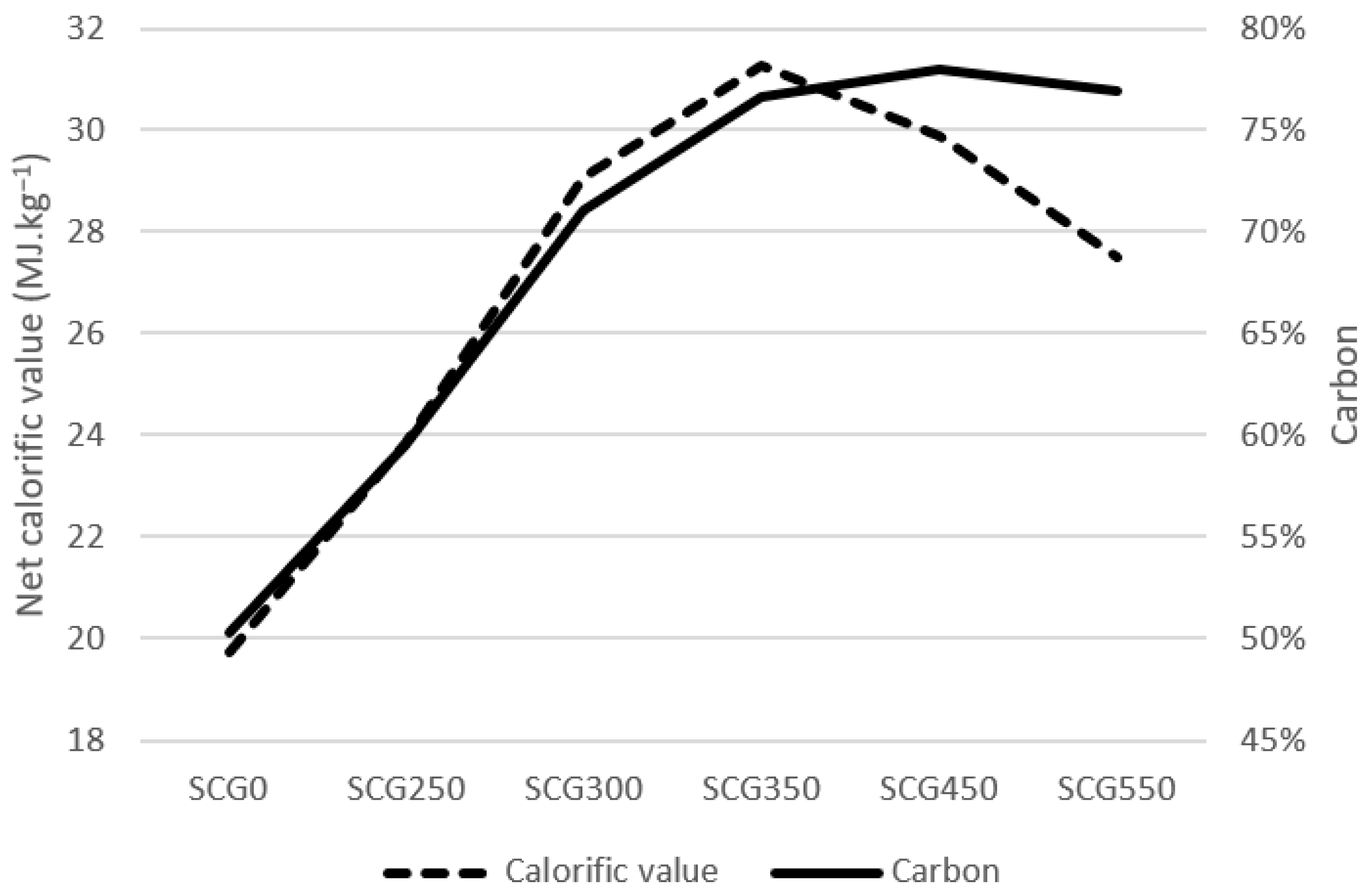
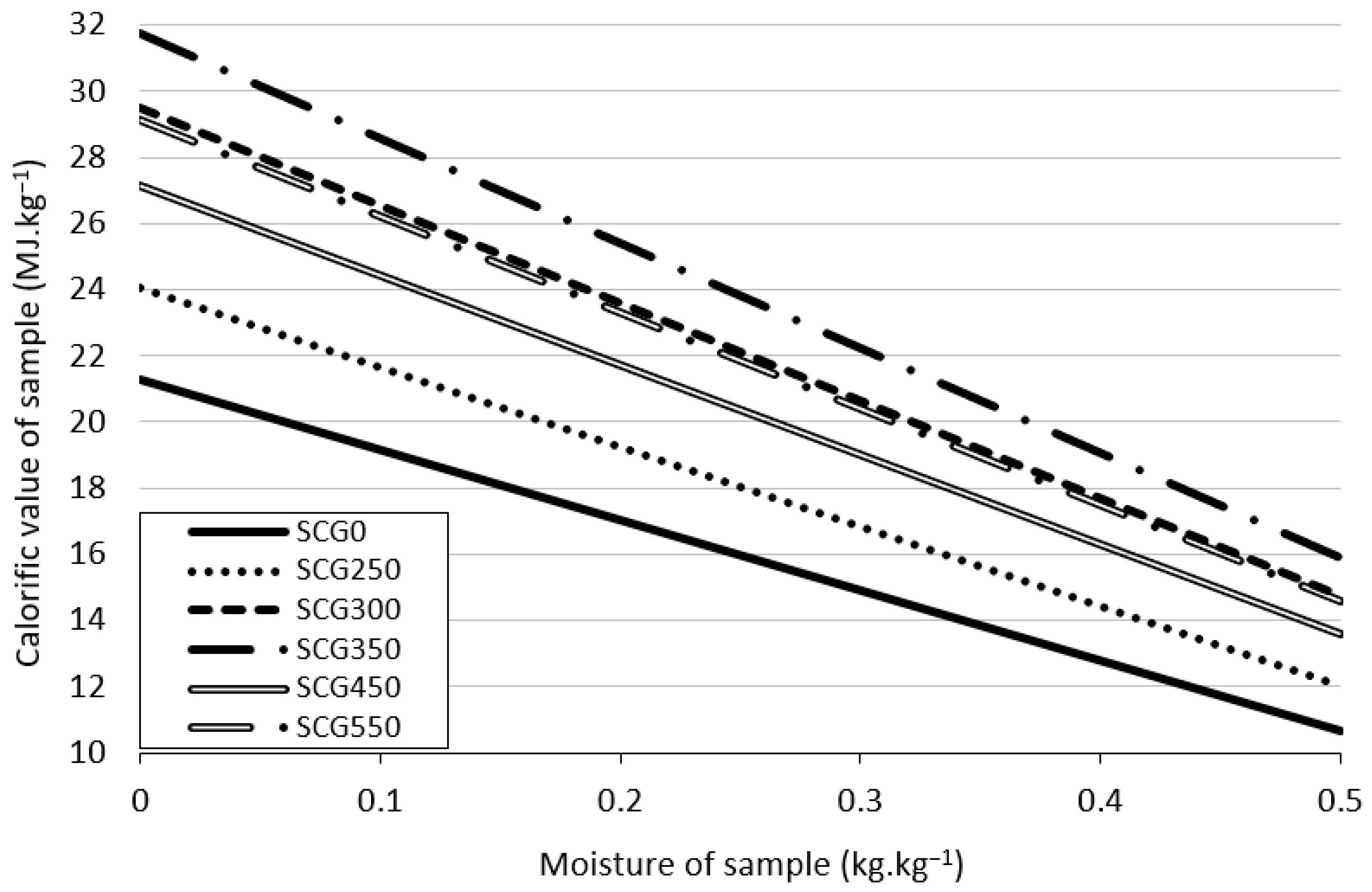
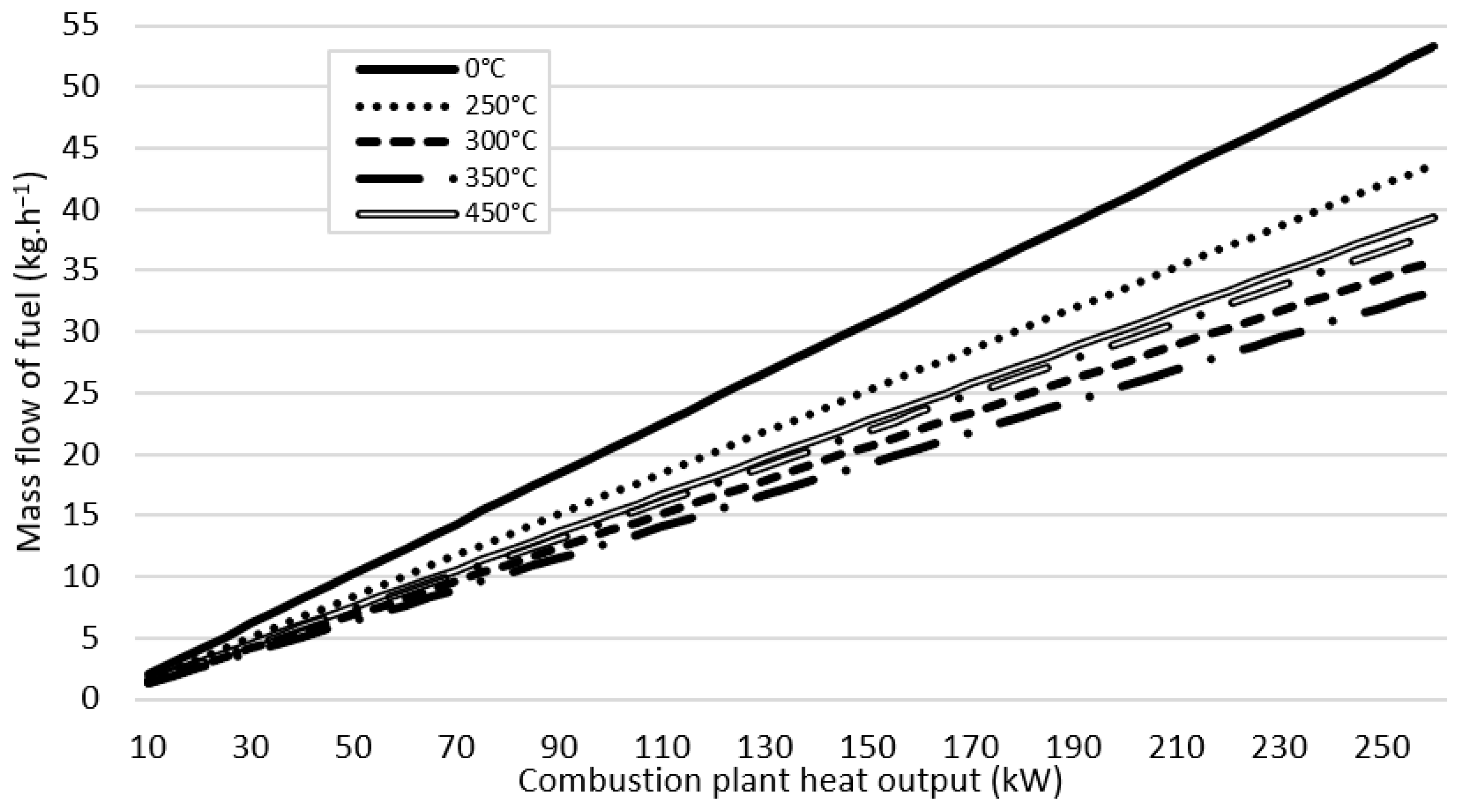
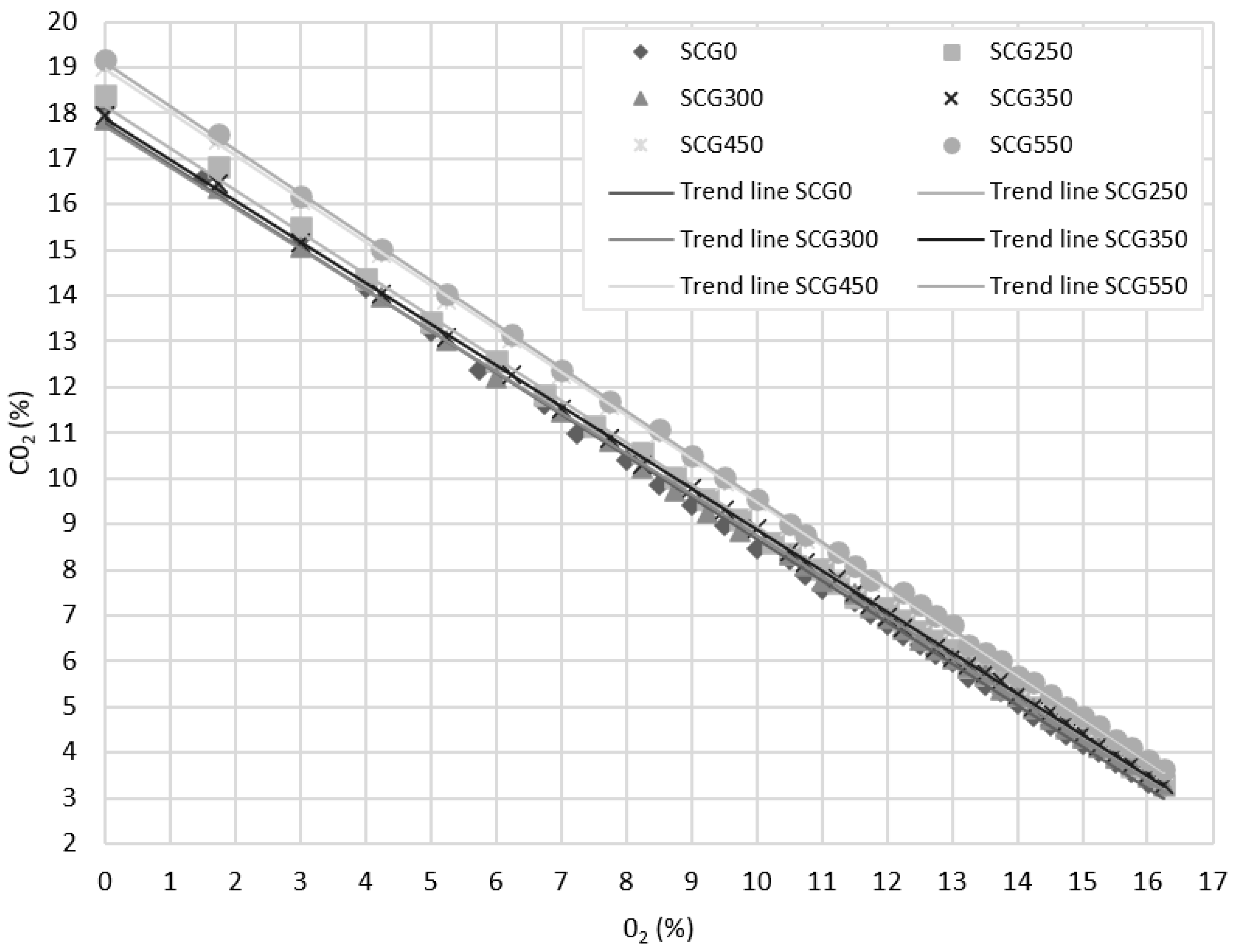


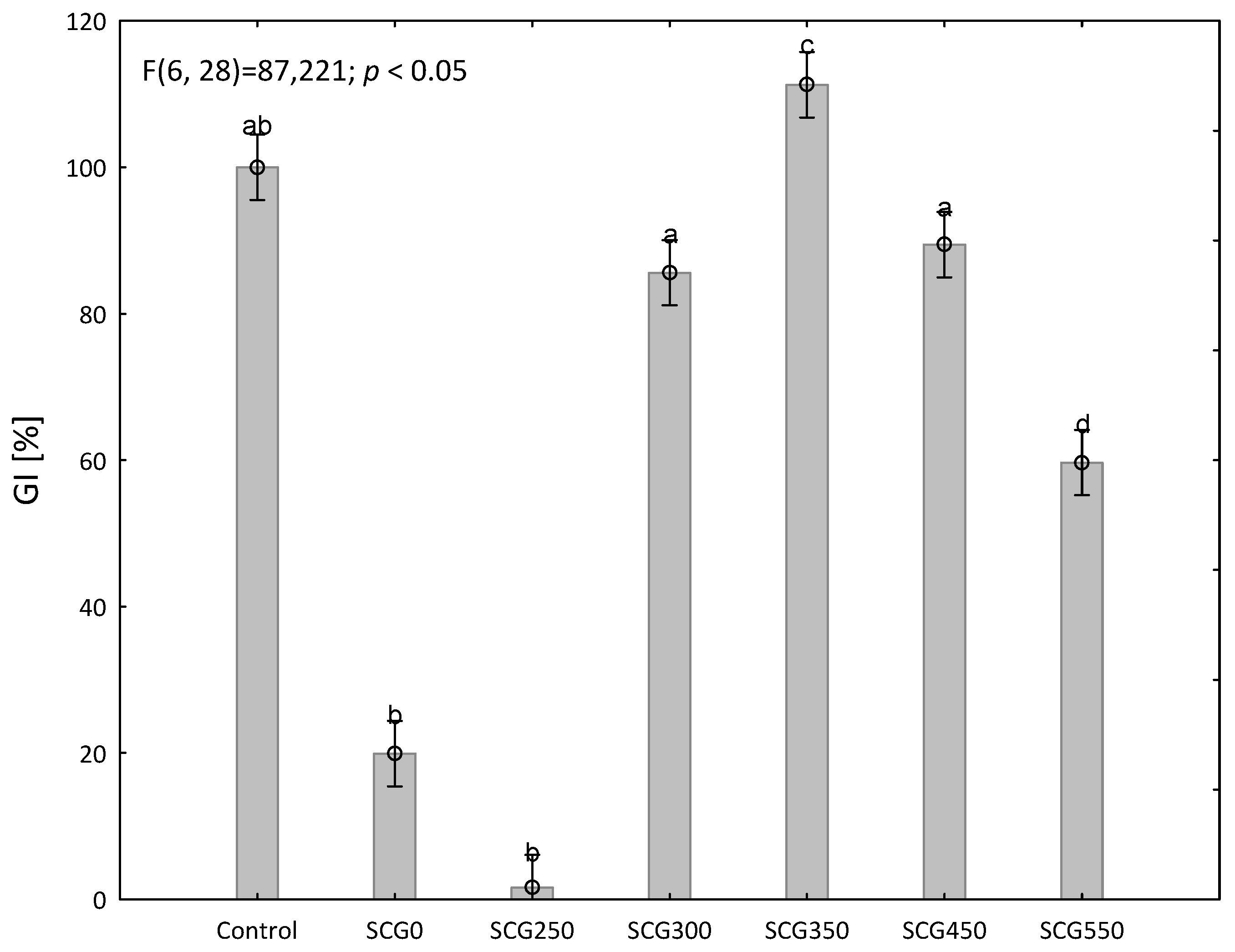
| Sample | Description | Final Temperature |
|---|---|---|
| SCG0 | Original dried SCG | - |
| SCG250 | Torrefied SCG | 250 °C |
| SCG300 | Torrefied SCG | 300 °C |
| SCG350 | Torrefied SCG | 350 °C |
| SCG450 | Torrefied SCG | 450 °C |
| SCG550 | Torrefied SCG | 550 °C |
| Sample | Moisture (% wt.) | Carbo (% wt.) | Hydrogen (% wt.) | Oxygen (% wt.) | Nitrogen (% wt.) | Ash (% wt.) | Net Calorific Value (MJ·kg−1) |
|---|---|---|---|---|---|---|---|
| SCG0 | 8.22 | 50.26 | 6.29 | 31.37 | 2.21 | 1.59 | 19.74 |
| SCG250 | 0.86 | 59.51 | 6.85 | 28.01 | 2.68 | 1.98 | 23.85 |
| SCG300 | 1.46 | 71.04 | 6.73 | 14.34 | 3.39 | 2.95 | 29.09 |
| SCG350 | 1.65 | 76.67 | 6.03 | 7.59 | 3.92 | 4.08 | 31.26 |
| SCG450 | 2.64 | 77.94 | 3.55 | 5.08 | 4.41 | 6.35 | 29.88 |
| SCG550 | 6.17 | 76.97 | 2.60 | 3.17 | 4.09 | 6.95 | 27.49 |
Publisher’s Note: MDPI stays neutral with regard to jurisdictional claims in published maps and institutional affiliations. |
© 2022 by the authors. Licensee MDPI, Basel, Switzerland. This article is an open access article distributed under the terms and conditions of the Creative Commons Attribution (CC BY) license (https://creativecommons.org/licenses/by/4.0/).
Share and Cite
Jeníček, L.; Tunklová, B.; Malaťák, J.; Neškudla, M.; Velebil, J. Use of Spent Coffee Ground as an Alternative Fuel and Possible Soil Amendment. Materials 2022, 15, 6722. https://doi.org/10.3390/ma15196722
Jeníček L, Tunklová B, Malaťák J, Neškudla M, Velebil J. Use of Spent Coffee Ground as an Alternative Fuel and Possible Soil Amendment. Materials. 2022; 15(19):6722. https://doi.org/10.3390/ma15196722
Chicago/Turabian StyleJeníček, Lukáš, Barbora Tunklová, Jan Malaťák, Michal Neškudla, and Jan Velebil. 2022. "Use of Spent Coffee Ground as an Alternative Fuel and Possible Soil Amendment" Materials 15, no. 19: 6722. https://doi.org/10.3390/ma15196722
APA StyleJeníček, L., Tunklová, B., Malaťák, J., Neškudla, M., & Velebil, J. (2022). Use of Spent Coffee Ground as an Alternative Fuel and Possible Soil Amendment. Materials, 15(19), 6722. https://doi.org/10.3390/ma15196722






